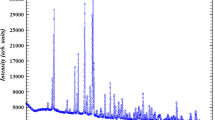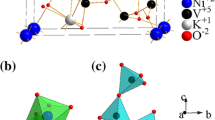Abstract
Na3V2O2(PO4)2F was synthesized by a facile hydrothermal route at 250 °C. The synthesized product (abbreviated NVPOF), characterized by X-ray diffraction (XRD) powder crystallizes in a tetragonal symmetry (space group: I4/mmm) with lattice parameters: a = 6.3956 Å, c = 10.6591 Å. The FTIR spectroscopy shows the characteristic peaks of (PO4)3− and V–O bonds. The morphology studied by scanning electron microscopy (SEM) shows that the image displays crystals with rectangular shape; the energy dispersive X-ray spectrometry (EDX) confirms the elements existing in the compound with a composition close to the chemical formulation. The bandgap energy (Eg = 1.63 eV) of NVPOF is consistent with its green pale color. We also reported for the first time the photo-electrochemical characterization. The Mott–Schottky characteristic, plotted in Na2SO4 solution, displays p-type behavior with holes as majority carriers, a flat band potential (Efb = 1.31 VSCE). The Electrochemical Impedance Spectroscopy (EIS) shows one semicircle in the frequency range (10 MHz—100 kHz), attributed to the charge transfer with a high impedance. As an application, the photoactivity of synthesized NVPOF was studied by degrading the methyl violet, a hazardous dye, under visible light irradiation. NVPOF is a potential photocatalyst for the photodegradation through the •OH and O2•− radicals. An abatement of 82% was obtained within 240 min and the kinetic follows a pseudo-first model with a half photocatalytic life of 98 min.












Similar content being viewed by others
References
A. Ahmad, M. Rafatullah, O. Sulaiman, M.H. Ibrahim, R. Hashim, Scavenging behaviour of meranti sawdust in the removal of methylene blue from aqueous solution. J. Hazard. Mater. 170, 357–365 (2009)
W. Zhang et al., Removal of dyes from aqueous solutions by straw based adsorbents: batch and column studies. Chem. Eng. J. 168, 1120–1127 (2011)
G.O. El-Sayed, Removal of methylene blue and crystal violet from aqueous solutions by palm kernel fiber. Desalination 272, 225–232 (2011)
J.-W. Lee, S.-P. Choi, R. Thiruvenkatachari, W.-G. Shim, H. Moon, Evaluation of the performance of adsorption and coagulation processes for the maximum removal of reactive dyes. Dyes Pigments 69, 196–203 (2006)
R.V. Kandisa, K.V.N. Saibaba, K.B. Shaik, R. Gopinath, Dye removal by adsorption: a review. J. Bioremediat. Biodegrad. (2016). https://doi.org/10.4172/2155-6199.1000371
J.N. Neetha, P. Ujwal, K. Sandesh, H. Santhosh, K. Girish, Aerobic biodegradation of acid blue-9 dye by Bacillus fermus isolated from Annona reticulata. Environ. Technol. Innov. 11, 253–261 (2018)
S. Popli, U.D. Patel, Destruction of azo dyes by anaerobic–aerobic sequential biological treatment: a review. Int. J. Environ. Sci. Technol. 12, 405–420 (2015)
L. Bay, K. West, B. Winther-Jensen, T. Jacobsen, Electrochemical reaction rates in a dye-sensitised solar cell—the iodide/tri-iodide redox system. Sol. Energy Mater. Sol. Cells 90, 341–351 (2006)
R. Bagtache, K. Abdmeziem, G. Rekhila, M. Trari, Synthesis and semiconducting properties of Na2MnPO4F. Application to degradation of rhodamine B under UV-light. Mater. Sci. Semicond. Process. 51, 1–7 (2016)
K.M. Lee, C.W. Lai, K.S. Ngai, J.C. Juan, Recent developments of zinc oxide based photocatalyst in water treatment technology: a review. Water Res. 88, 428–448 (2016)
R. Bagtache, G. Rekhila, K. Abdmeziem, M. Trari, Characterization of a copper phosphate triazole metal organic framework material (Cu3PO4 (C2N3H2) 2OH) and oxygen evolution studies. Mater. Sci. Semicond. Process. 23, 144–150 (2014)
K. Zhang, L. Guo, Metal sulphide semiconductors for photocatalytic hydrogen production. Catal. Sci. Technol. 3, 1672–1690 (2013)
D. Ayodhya, G. Veerabhadram, A review on recent advances in photodegradation of dyes using doped and heterojunction based semiconductor metal sulfide nanostructures for environmental protection. Mater. Today Energy 9, 83–113 (2018)
S. Liu, J. Yu, B. Cheng, M. Jaroniec, Fluorinated semiconductor photocatalysts: tunable synthesis and unique properties. Adv. Colloid Interface. Sci. 173, 35–53 (2012)
A. Sivakumar, B. Murugesan, A. Loganathan, P. Sivakumar, A review on decolourisation of dyes by photodegradation using various bismuth catalysts. J. Taiwan Inst. Chem. Eng. 45, 2300–2306 (2014)
X. Meng, Z. Zhang, Bismuth-based photocatalytic semiconductors: introduction, challenges and possible approaches. J. Mol. Catal. A 423, 533–549 (2016)
W.-Q. Kan et al., Four polyoxometalate-based semiconductive coordination polymers: syntheses, structures, photoluminescent and photocatalytic properties. Synth. Met. 198, 51–58 (2014)
T.A. Taha, S. Elrabaie, M.T. Attia, Exploring the structural, thermal and dielectric properties of PVA/Ni0.5Zn0.5Fe2O4 composites. J. Electron. Mater. 48, 6797–6806 (2019)
T.A. Taha, A. Hassona, S. Elrabaie, M.T. Attia, Dielectric spectroscopy of PVA-Ni0.5Zn0.5Fe2O4 polymer nanocomposite films. J. Asian Ceram. Soc. 8, 1076–1082 (2020)
P. Serras, V. Palomares, T. Rojo, H.E.A. Brand, N. Sharma, Structural evolution of high energy density V 3+/V 4+ mixed valent Na 3 V 2 O 2x (PO 4) 2 F 3–2x (x= 0.8) sodium vanadium fluorophosphate using in situ synchrotron X-ray powder diffraction. J. Mater. Chem. A 2, 7766–7779 (2014)
Y. Park et al., A family of high-performance cathode materials for Na-ion batteries, Na3 (VO1− xPO4) 2 F1+ 2x (0≤ x≤ 1): combined first-principles and experimental study. Adv. Func. Mater. 24, 4603–4614 (2014)
Y. Qi et al., Superior Na-storage performance of low-temperature-synthesized Na3 (VO1− xPO4) 2F1+ 2x (0≤ x≤ 1) nanoparticles for Na-Ion batteries. Angew. Chem. Int. Ed. 54, 9911–9916 (2015)
N. Sharma et al., Sodium distribution and reaction mechanisms of a Na3V2O2 (PO4) 2F electrode during use in a sodium-ion battery. Chem. Mater. 26, 3391–3402 (2014)
J. Guo et al., High-energy/power and low-temperature cathode for sodium-ion batteries: in situ XRD study and superior full-cell performance. Adv. Mater. 29, 1701968 (2017)
Z.-Y. Gu et al., Precisely controlled preparation of an advanced Na 3 V 2 (PO 4) 2 O 2 F cathode material for sodium ion batteries: the optimization of electrochemical properties and electrode kinetics. Inorg. Chem. Front. 6, 988–995 (2019)
L. Bi et al., Improving electrochemical performance of Na3 (VPO4) 2O2F cathode materials for sodium ion batteries by constructing conductive scaffold. Electrochim. Acta 337, 135816 (2020)
X.-X. Zhao et al., Temperature-dependent electrochemical properties and electrode kinetics of Na3V2 (PO4) 2O2F cathode for sodium-ion batteries with high energy density. Chemistry (2020). https://doi.org/10.1002/chem.202000943
H. Tan, X.Z. Yu, K. Huang, J. Zhong, B. Lu, Large-scale carambola-like V2O5 nanoflowers arrays on microporous reed carbon as improved electrochemical performances lithium-ion batteries cathode. J. Energy Chem. 51, 388–395 (2020)
G. Deng et al., Graphene quantum dots-shielded Na3 (VO) 2 (PO4) 2F@ C nanocuboids as robust cathode for Na-ion battery. Energy Storage Mater. 5, 198–204 (2016)
Y. Yin et al., Robust three-dimensional graphene skeleton encapsulated Na3V2O2 (PO4) 2F nanoparticles as a high-rate and long-life cathode of sodium-ion batteries. Nano Energy 41, 452–459 (2017)
P.R. Kumar, Y.H. Jung, J.E. Wang, D.K. Kim, Na3V2O2 (PO4) 2F-MWCNT nanocomposites as a stable and high rate cathode for aqueous and non-aqueous sodium-ion batteries. J. Power Sources 324, 421–427 (2016)
W. Chang et al., Freestanding Na3V2O2 (PO4) 2F/graphene aerogels as high-performance cathodes of sodium-ion full batteries. ACS Appl. Mater. Interfaces. 12, 41419–41428 (2020)
M. Xu et al., Na 3 V 2 O 2 (PO 4) 2 F/graphene sandwich structure for high-performance cathode of a sodium-ion battery. Phys. Chem. Chem. Phys. 15, 13032–13037 (2013)
L.-L. Zhang et al., N/P-dual-doped carbon-coated Na3V2 (PO4) 2O2F microspheres as a high-performance cathode material for sodium-ion batteries. ACS Appl. Mater. Interfaces. 12, 3670–3680 (2019)
Y. Qi et al., Scalable room-temperature synthesis of multi-shelled Na3 (VOPO4) 2F microsphere cathodes. Joule 2, 2348–2363 (2018)
M. Peng et al., Hierarchical Ru-doped sodium vanadium fluorophosphates hollow microspheres as a cathode of enhanced superior rate capability and ultralong stability for sodium-ion batteries. Nano Energy 31, 64–73 (2017)
F. Sauvage, E. Quarez, J.-M. Tarascon, E. Baudrin, Crystal structure and electrochemical properties vs.Na+ of the sodium fluorophosphate Na1. 5VOPO4F0. 5. Solid State Sci. 8, 1215–1221 (2006)
R. López, R. Gómez, Band-gap energy estimation from diffuse reflectance measurements on sol–gel and commercial TiO 2: a comparative study. J. Sol Gel. Sci. Technol. 61, 1–7 (2012)
A.S. Abouhaswa, T.A. Taha, Tailoring the optical and dielectric properties of PVC/CuO nanocomposites. Polym. Bull. 77, 6005–6016 (2020)
N. Hassan, A.M. Mansour, N. Roushdy, A.A.M. Farag, W.G. Osiris, Optical sensing performance characteristics of schottky devices diodes based nano-particle disodium 6-hydroxy-5-[(2-methoxy-5-methyl-4-sulfophenyl)azo]-2-naphthalenesulfonate thin films: a comparison study. Optik 158, 1255–1265 (2018)
A.M. Mansour, A.B. Abou Hammad, A.M. El Nahrawy, Sol–gel synthesis and physical characterization of novel MgCrO4-MgCu2O3 layered films and MgCrO4-MgCu2O3/p-Si based photodiode. Nano Struct. Nano Objects 25, 100646 (2021)
A.M. El Nahrawy, A.B. Abou Hammad, A.M. Mansour, Compositional effects and optical properties of P2O5 doped magnesium Silicate mesoporous thin films. Arab. J. Sci. Eng. (2020). https://doi.org/10.1007/s13369-020-05067-4
J. Ângelo, P. Magalhães, L. Andrade, A. Mendes, Characterization of TiO2-based semiconductors for photocatalysis by electrochemical impedance spectroscopy. Appl. Surf. Sci. 387, 183–189 (2016)
A. Butler, The coordination and redox chemistry of vanadium in aqueous solution, in Vanadium in Biological Systems. ed. by N. Dennis Chasteen (Springer, Dordrecht, 1990), pp. 25–49
Z. Zhang et al., Toward high power-high energy sodium cathodes: a case study of bicontinuous ordered network of 3D porous Na3 (VO) 2 (PO4) 2F/rGO with pseudocapacitance effect. Small 15, 1900356 (2019)
C. Ma et al., Mechanism investigation of high performance Na3V2 (PO4) 2O2F/reduced graphene oxide cathode for sodium-ion batteries. J. Power Sources 482, 228906 (2021)
M. Metikoš-Huković, Z. Grubač, S. Omanovic, Change of n-type to p-type conductivity of the semiconductor passive film on N-steel: enhancement of the pitting corrosion resistance. J. Serb. Chem. Soc. 78, 2053–2067 (2013)
S. Dhillon, R. Kant, Theory for electrochemical impedance spectroscopy of heterogeneous electrode with distributed capacitance and charge transfer resistance. J. Chem. Sci. 129, 1277–1292 (2017)
D. Chen et al., Oxyvanite V 3 O 5: a new intercalation-type anode for lithium-ion battery. InfoMat (2019). https://doi.org/10.1002/inf2.12011
K. Atacan, N. Güy, B. Boutra, M. Özacar, Enhancement of photoelectrochemical hydrogen production by using a novel ternary Ag2CrO4/GO/MnFe2O4 photocatalyst. Int. J. Hydrog. Energy 45, 17453–17467 (2020)
K. Rajeshwar, Fundamentals of semiconductor electrochemistry and photoelectrochemistry. Encycl. Electrochem. 6, 1–53 (1990)
J.A. Glasscock, P.R.F. Barnes, I.C. Plumb, N. Savvides, Enhancement of photoelectrochemical hydrogen production from hematite thin films by the introduction of Ti and Si. J. Phys. Chem. C 111, 16477–16488 (2007)
W. Zhao et al., Facile in-suit synthesis of Ag/AgVO3 one-dimensional hybrid nanoribbons with enhanced performance of plasmonic visible-light photocatalysis. Appl. Catal. B 163, 288–297 (2015)
A. Kumar, G. Pandey, A review on the factors affecting the photocatalytic degradation of hazardous materials. Mater. Sci. Eng. Int. J. 1, 00018 (2017)
S. Alkaykh, A. Mbarek, E.E. Ali-Shattle, Photocatalytic degradation of methyleneblue dye in aqueous solution by MnTiO3 nanoparticles under sunlight irradiation. Heliyon 6, e03663 (2020)
S. Hisaindee, M.A. Meetani, M.A. Rauf, Application of LC-MS to the analysis of advanced oxidation process (AOP) degradation of dye products and reaction mechanisms. TrAC Trends Anal. Chem. 49, 31–44 (2013)
Acknowledgements
The authors acknowledge the funding (Grant N° B00L01UN160420190020) from the Faculty of Chemistry (Algiers), Algeria.
Author information
Authors and Affiliations
Corresponding authors
Additional information
Publisher's Note
Springer Nature remains neutral with regard to jurisdictional claims in published maps and institutional affiliations.
Rights and permissions
About this article
Cite this article
Tartaya, S., Bagtache, R., Djaballah, A.M. et al. Preparation and photo-electrochemical characterization of the vanadium fluorophosphate Na3V2O2(PO4)2F. application to the photo degradation of methyl violet. J Mater Sci: Mater Electron 32, 15441–15452 (2021). https://doi.org/10.1007/s10854-021-06093-0
Received:
Accepted:
Published:
Issue Date:
DOI: https://doi.org/10.1007/s10854-021-06093-0




